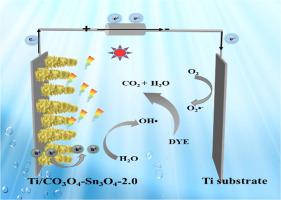Chemical Engineering Journal ( IF 13.3 ) Pub Date : 2021-05-08 , DOI: 10.1016/j.cej.2021.130252 Ming Li , Wenfeng Li , Jiahui Lyu , Mahamat Ahmat Moussa , Xinghui Liu , Yinghuan Fu , Hongchao Ma

|
Refractory organic pollutants' degradation efficiency strongly depends on the amount of intermediate active species (hydroxyl radical and superoxide radical) in the photoelectrocatalytic (PEC) process. Here, the various amount of Sn3O4 nanosheets is adhered to the surface of Co3O4 nanowires by a simple hydrothermal process to assemble the Co3O4-Sn3O4 hierarchical nanoflower-tree architecture. The as-obtained Co3O4-Sn3O4-2.0 (2 mmol tin salt precursor) photoelectrodes exhibited superior PEC dye degradation efficiency than bare Co3O4 photoelectrode because the Co3O4-Sn3O4-2.0 hierarchical architecture has large electrochemical active, fast interfacial carrier transport, low electrochemical resistance, a proper bandgap, high electron-hole separation efficiency, and electron-deficient surface. Especially, Co3O4-Sn3O4-2.0 hierarchical architecture can promote the generation of intermediate active species (hydroxyl radical and superoxide radical) as the demonstration from the energy band structures, which play the predominant role in the PEC process. Additionally, the electron-deficient surface enhances the interaction with active species and increases stability during the PEC process. Overall, Co3O4-Sn3O4-2.0 architecture demonstrated the best PEC degradation rate (~87.5% in 2 h) and long-term stability (~13,000 s) in 0.1 mol/L Na2SO4 toward the accelerated degradation of reactive brilliant blue KN-R. The present work provides a feasible and straightforward route to obtain highly efficient PEC photoanode through a rational combination of Co3O4 and Sn3O4 with proper energy band tuning, which will guide other heterojunction designs.
中文翻译:

具有增强的光电催化效率的水净化去污Co 3 O 4 -Sn 3 O 4分层纳米花树异质结构
难降解有机污染物的降解效率在很大程度上取决于光电催化(PEC)过程中中间活性物质(羟基自由基和超氧化物自由基)的数量。在此,通过简单的水热工艺将各种数量的Sn 3 O 4纳米片粘附到Co 3 O 4纳米线的表面,以组装Co 3 O 4 -Sn 3 O 4分层纳米花树结构。所获得的Co 3 O 4 -Sn 3 O 4 -2.0(2 mmol锡盐前体)光电极表现出比裸Co优异的PEC染料降解效率。3 O 4光电极,因为Co 3 O 4 -Sn 3 O 4 -2.0分层结构具有大的电化学活性,快速的界面载流子传输,低的电化学电阻,适当的带隙,高的电子-空穴分离效率和电子不足的表面。特别地,Co 3 O 4 -Sn 3 O 4-2.0分层结构可以促进中间活性物质(羟基自由基和超氧化物自由基)的产生,这是从能带结构中证明的,它们在PEC过程中起主要作用。此外,缺电子的表面增强了与活性物质的相互作用,并增加了PEC过程中的稳定性。总体而言,Co 3 O 4 -Sn 3 O 4 -2.0体系在0.1 mol / L Na 2 SO 4中表现出最佳的PEC降解率(2小时内约87.5%)和长期稳定性(约13,000 s)。促进活性艳蓝KN-R的加速降解。本工作为通过合理结合能带调谐的Co 3 O 4和Sn 3 O 4的合理组合提供了一种获得高效PEC光电阳极的可行而直接的途径,这将指导其他异质结设计。











































 京公网安备 11010802027423号
京公网安备 11010802027423号